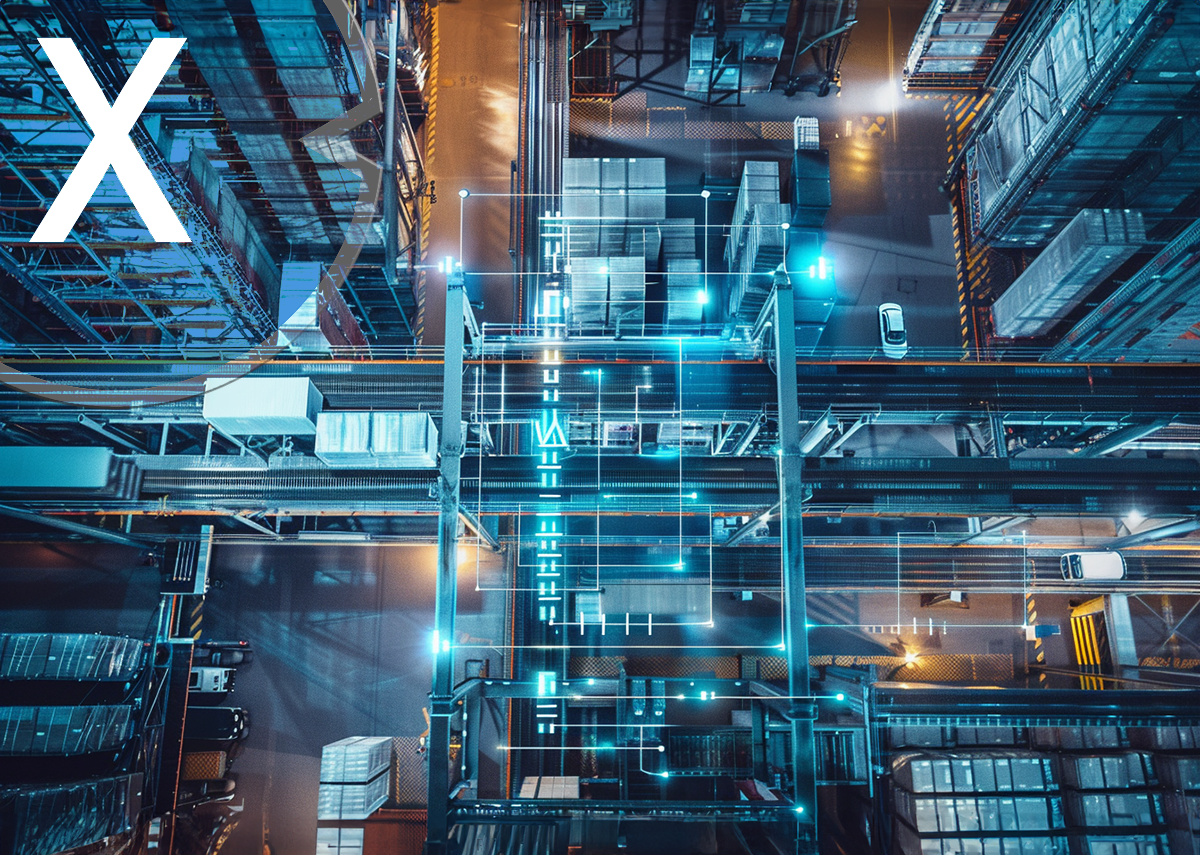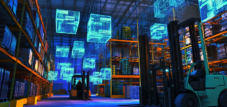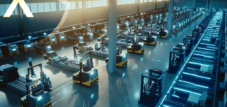Competitive advantage through automation: warehouse automation, connected warehouse processes and intelligent automation systems
Language selection 📢
Published on: September 18, 2024 / Updated on: November 28, 2025 – Author: Konrad Wolfenstein

Competitive advantage through intelligent automation systems: The future of warehouse automation and networked warehouse processes – Image: Xpert.Digital
🏭🔍 From warehouse to high-tech center: The rise of automation systems
⚙️📊 Optimization on the rise: How automation keeps companies competitive
In a world that is becoming increasingly digital and in which global competition is becoming increasingly intense, companies are forced to optimize their processes in order to remain competitive. One area where this is particularly evident is warehousing. Modern warehouse automation systems and networked processes offer companies enormous potential to increase their efficiency and ensure their competitiveness. This article explores how intelligent automation systems are revolutionizing the future of warehousing and the benefits companies can achieve as a result.
🚀 The growing importance of warehouse automation
Warehousing has historically been a labor-intensive area that relies on manual processes. This often led to errors, inefficiencies and delays in the supply chain. But with the advent of new technologies, particularly automation, this picture has changed fundamentally. Companies are increasingly recognizing the need to automate their warehouse processes to meet the increasing demands of globalized markets.
“Automation in warehouses has long since become not just an option, but a necessity.” This statement sums up the fact that manual processes can no longer meet modern requirements. The use of intelligent automation systems that integrate robots, artificial intelligence (AI) and the Internet of Things (IoT) enables companies to make their warehouse processes faster, more efficient and error-free.
🧠 Intelligent automation systems: What sets them apart
Intelligent automation systems go far beyond simple mechanization. They are based on using data and implementing advanced technologies to make decisions in real time. These systems include, among others:
Robotic technology
Robots take on numerous tasks in modern warehouses, from picking and packing to transporting goods. These robots work quickly, precisely and around the clock, significantly increasing productivity.
Artificial intelligence and machine learning
AI-driven systems analyze large amounts of data and can make predictions that optimize warehouse operations. For example, algorithms can identify the ideal storage location for certain products or predict when certain items need to be reordered.
Networked systems (IoT)
The Internet of Things makes it possible to network machines and systems with each other and exchange information in real time. For example, sensors in shelves can monitor the level of inventory and automatically request replenishment if certain threshold values are exceeded.
These technologies optimize the entire warehouse process, from delivery to storage and shipping. Automation eliminates many sources of error and reduces costs by requiring less manual intervention and significantly increasing productivity.
💡 Advantages of intelligent warehouse automation
Implementing intelligent automation systems offers companies a variety of benefits that directly impact their competitiveness. Some of these benefits include:
Greater efficiency and speed
By using robots and networked systems, warehouse processes can be carried out significantly faster. For example, orders can be picked and shipped in a very short time. This leads to improved customer satisfaction as delivery times are shortened and errors are minimized.
Cost reduction
Automation reduces the need for manual labor, which is a significant advantage, especially in times of rising labor costs. In addition, more precise processes reduce errors, which in turn reduces the costs of returns and rework.
Improved inventory management
Thanks to connected systems and IoT technology, inventory can be monitored in real time. This allows for more accurate planning and reduces the risk of overstocking or stockouts. This allows companies to react more efficiently to fluctuations in demand and optimize their inventory levels.
Flexibility and scalability
Automation systems can be flexibly adapted to changing requirements. This is particularly beneficial during times of growth or seasonal peaks. An automated warehouse can respond quickly to higher order volumes without requiring additional resources.
Increased security
In many warehouses, there is a significant risk of accidents, especially with manual processes. The use of robots and automation systems significantly reduces the risk of accidents at work, as many dangerous tasks are carried out by machines.
🔮 Networked warehouse processes: The warehouse of the future
In addition to automation, the networking of warehouse processes plays a central role in the future of warehousing. A connected warehouse relies on the integration of IoT, AI and data analytics to ensure seamless communication between all components of the warehouse. This not only enables greater efficiency, but also better control and monitoring of the entire warehouse operation.
In a networked warehouse, machines, sensors and systems continuously exchange data. For example, autonomous vehicles can automatically transport goods from one area of the warehouse to another, while AI algorithms calculate the optimal route to save time and energy. At the same time, sensors monitor the condition of the machines in order to plan maintenance in good time and minimize downtime.
However, this networking extends not only to the warehouse itself, but also to other areas of the supply chain. For example, information about inventory levels can be shared with suppliers in real time to plan replenishment more efficiently. Customers can also be directly involved in the process by informing them about the status of their orders.
⚠️ Challenges of warehouse automation
Despite the numerous benefits, companies also face challenges when implementing intelligent automation systems. One of the biggest hurdles is the high investment costs associated with the introduction of such systems. Not every company has the financial resources to implement comprehensive automation projects. However, it is important to remember that the long-term cost savings and efficiency gains often justify the initial investment.
Another obstacle is the integration of existing systems into the new automation environment. Many companies have outdated IT infrastructures that are not easily compatible with modern automation systems. Careful planning and collaboration with experienced technology partners are therefore crucial to ensure a smooth integration.
Finally, automation also requires new skills and knowledge from employees. Companies must ensure that their workforce is trained to use new technologies and develops the necessary skills to fully exploit the potential of automation.
🌐 The future of warehouse automation
The future of warehousing undoubtedly lies in the automation and networking of processes. Intelligent automation systems offer companies the opportunity to increase their efficiency, reduce costs and ensure their competitiveness. Especially in a globalized world where speed and precision are crucial success factors, automation can provide a significant competitive advantage.
Companies that adopt these technologies early on will be able to adapt to the changing demands of the market and strengthen their position in the long term. The integration of robots, AI and networked systems will not only increase efficiency, but also improve flexibility and scalability - essential factors for continued success in the future.
Automation is not just a trend, it is the future of warehousing. Companies that recognize this and invest in intelligent automation systems will be tomorrow's winners.
📣 Similar topics
- 🤖 Intelligent automation: The future of warehousing
- 🏭 Efficiency through robotic technology in warehouses
- 📈 AI and machine learning for optimized warehouse processes
- 🌐 Connected systems and IoT in the modern warehouse
- 🚀 Faster and error-free: advantages of automation
- 🔍 Real-time data analysis for inventory management
- ⚙️ Scalability and flexibility through automation
- 💼 Cost reduction in warehousing through automation
- 🛡️ Safety in the warehouse: robots instead of people
- 🔧 Warehouse automation challenges and solutions
#️⃣ Hashtags: #warehouse automation #increasing efficiency #artificialintelligence #connectedprocesses #costreduction
LTW Solutions
LTW offers its customers not individual components, but integrated complete solutions. Consulting, planning, mechanical and electrotechnical components, control and automation technology, as well as software and service – everything is networked and precisely coordinated.
In-house production of key components is particularly advantageous. This allows for optimal control of quality, supply chains, and interfaces.
LTW stands for reliability, transparency, and collaborative partnership. Loyalty and honesty are firmly anchored in the company's philosophy – a handshake still means something here.
Suitable for:
We are there for you - advice - planning - implementation - project management
☑️ Smart City & Factory: Industry expert for energetic 5G buildings and halls as well as advice and installation of solar systems
☑️ Xpert.Plus - logistics consulting and logistics optimization
☑️ Industry expert, here with his own Xpert.Digital Industry Hub with over 2,500 specialist articles
I would be happy to serve as your personal advisor.
You can contact me by filling out the contact form below or simply call me on +49 89 89 674 804 (Munich) .
I'm looking forward to our joint project.
Xpert.Digital - Konrad Wolfenstein
Xpert.Digital is a hub for industry with a focus on digitalization, mechanical engineering, logistics/intralogistics and photovoltaics.
With our 360° business development solution, we support well-known companies from new business to after sales.
Market intelligence, smarketing, marketing automation, content development, PR, mail campaigns, personalized social media and lead nurturing are part of our digital tools.
You can find out more at: www.xpert.digital - www.xpert.solar - www.xpert.plus

























